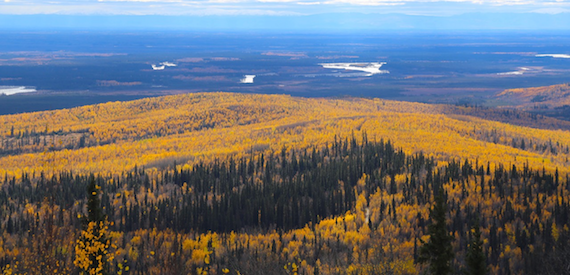What we are learning from ABoVE Research

|
|
Photo courtesy of Glenn Juday, taken from Parks Highway overlook 22 September 2015
|
Authors: Natalie Boelman, Abhishek Chatterjee, Roisin Commane, Scott Goetz, Mike Goulden, Peter Griffith, Joshua Fisher, John Kimball, Michelle Mack, Chip Miller, Sue Natali (authorship is alphabetical order reflecting equal contributions to this effort). We thank all the WG members who contributed input and ideas.
The Working Group Leads and Science Leadership Group (SLG) have been assessing input from members of the primary science working groups (Carbon Dynamics, Fire Disturbance, Permafrost and Hydrology, Vegetation Dynamics, Wildlife and Ecosystem Services, and Modeling), with the goal of summarizing what we are learning from ABoVE research efforts thus far. Each WG lead surveyed their group for input and then, working with one another and the SLG, combined input on various themes to highlight some key areas of progress. The following summary is not meant to be exhaustive but rather a brief overview of some of what we're learning and why it matters. Part of the criteria was one or more refereed publication(s) to support each highlight. Here we provide a brief highlights from each of the WGs. More highlights of what we're learning will be forthcoming in future communications, as publications continue to come out, and will also be summarized in an overview publication in preparation for the Environmental Research Letters Focus Collection of ABoVE research.
Carbon Dynamics
Non-Growing Season (sometimes referred to as Winter) carbon emissions are a significant fraction of the annual carbon budget and are increasing. Increasing temperatures are extending the season for soil respiration, which may offset increased CO2 uptake by vegetation in the growing season. Non-Growing Season (NGS) CO2 and methane (CH4) fluxes in tundra are increasing with longer duration of the period in spring and fall when water is in a phase transition between liquid and frozen states (the so-called "zero curtain"). There has been a 73% increase in North Slope CO2 emissions in the October - December timeframe, as measured at the NOAA Barrow tall tower since 1979, consistent with increased emissions at the Arctic eddy flux tower near Barrow operating since 1998. This is also consistent with high CO2 and CH4 concentrations observed by airborne data well into November. Trends in modeled carbon budgets for the ABoVE domain show gross primary production offsets net ecosystem respiration losses (i.e,, a net sink), but spatial trend analyses indicate localized landscape vulnerability where ecosystems are moving towards net carbon loss, and increases in CH4 flux along northern boreal transitional zones underlain by permafrost. The C Dynamics WG is interacting with other WGs to reconcile the observations with the models, what they portend for the future C balance of the ABoVE domain, and ultimately their implications for climate feedbacks across the Arctic.
Wildfire Disturbance
Lightning dynamics are a major driver of large fire years within the ABoVE domain. There is evidence that warming is increasing the vulnerability of the taiga-tundra transition region to lightning and fires, which could facilitate treeline migration if seed sources are available and then initiate a positive feedback through regional warming, increased lightning, and fire disturbance. The 2014 mega-fires in the Northwest Territories emitted 94.3 Tg C from 2.85 Mha of burned area, which is equal to about half of the annual carbon sequestration by Canadian boreal forest ecosystems and over ten times the mean annual sequestration of Alaskan boreal forests. Increasing burn severity is affecting forest regeneration and permafrost dynamics, key controls over the post-fire carbon cycle. Deep burning of the soil organic layer is leading to decreased conifer regeneration in boreal Canada and Alaska, potentially shifting ecosystems to alternate successional trajectories such as deciduous forests or open wetlands. Deep burning also increases post-fire depth of thaw and renders permafrost vulnerable to degradation. In boreal Alaska, deeper burning resulted in warmer soils and deeper thaw. In Arctic tundra, post-fire increases in thaw depth took 45 years to return to pre-fire levels. The dynamics of wildfire have implications for carbon balance, vegetation composition, wildlife habitat, permafrost and hydrology, thus cut across ABoVE research themes and working groups.
Vegetation Dynamics
ABoVE researchers are finding growing evidence of ongoing changes in boreal forest productivity even after removing the effects of wildfire. Part of this reflects local shifting mosaics, where changes in hydrology and drainage are linked to vegetation changes across the landscape. Another part is related to forest mortality, especially in older stands and at the southern boreal forest margins where drought, longer-term stress and dieback are linked. A third part reflects large scale shifts in vegetation distribution, with forest densification near the cold edge of forest distribution and dieback near the warm edge. Exploration of landscape scale productivity trends is underway in the tundra portion of the ABoVE domain as well. These analyses have only become possible in the last few years with improved Landsat Surface Reflectance datasets and the ability to process thousands of images in high performance computing environments. Understanding and predicting changes to vegetation is critical for understanding biospheric feedbacks to the climate system.
Hydrology & Permafrost
Integrated model and satellite data analyses confirm widespread permafrost degradation across Alaska. New satellite data-driven model assessments indicate widespread active layer thickness (ALT) deepening across Alaska, affecting approximately 79% of near surface (≤3m depth) permafrost areas over the 2001-2015 record. Driven by recent warming and longer snow-free season trends, permafrost thawing and active layer deepening is particularly intense over central and southwest Alaska, with melt rates exceeding 3 cm yr-1 in some areas. Other model projections of future conditions for Alaska indicate that surface (≤1m depth) and deeper (up to 5m) permafrost layers are vulnerable to being reduced by up to 74% and 55%, respectively, by the end of this century. Changes of this magnitude will have major implications for human infrastructure (roads, pipelines, etc) and, if representative of other Arctic and boreal regions, for climate feedbacks.
Wildlife & Ecosystem Services
Satellite and field assessments of snowpack properties in mountain sheep habitat show scale-dependent responses of sheep to snow conditions. MODIS time series of normalized difference snow index (NDSI) and MODIS-calibrated SnowModel estimates of snow depth and density provide predictors of Dall sheep movements during the winter at multiple spatial and temporal scales. SnowModel is a spatially distributed snow-evolution modeling system that is an aggregation of four submodels on meteorological forcing conditions, surface energy exchanges, snow depth and snow water-equivalent evolution, and snow redistribution by wind. SnowModel can be run on grid increments of 1m to 10s of km, and at temporal increments of 10 min to 1 day. Including the NDSI metrics substantially improved model performance and informed predictions of winter Dall sheep movements. SnowModel snow depth outperformed NDSI in capturing movements made at finer intervals (<5 days). At these scales, Dall sheep selected for snow depths below mean chest height (<54-cm) when in low density snows (100 kg/m3), which may facilitate access to ground forage and reduce energy expenditure while traveling. However, sheep selected for higher snow densities (> 300 kg/m3) at snow depths above chest height, which likely further reduced energy expenditure by limiting hoof penetration in deeper snows. NDSI described movements best at intervals longer than ~5 days. Thus, use of publicly available, remotely sensed snow cover products can substantially improve models of animal movement, even when such products were not developed for the specific purposes of animal movement modeling. Analyses of other species and how their movements relate to snow properties is ongoing.
Modeling
It is well known that models are deficient in representing Arctic-Boreal ecosystem processes (for instance, results from warming experiments contradict projections from the 5th Carbon Model Intercomparison Project, CMIP5), but the data requirements had not previously been quantified and delineated across the modeling community. A survey of 18 modeling teams compiled the data most needed to advance modeling in Arctic-Boreal ecosystems, as follows: [Tier 1–top priority] soil carbon, net primary production, biomass, soil moisture, plant functional type discrimination, and gross primary production; [Tier 2–secondary priority] soil respiration, litter mass, active layer thickness, freeze/thaw dynamics, net ecosystem exchange, soil temperature, evapotranspiration, water table, permafrost, soil vertical profiles, and leaf area index. Specific areas within the ABoVE domain were identified as locations with high model uncertainties. A roadmap has been defined using this information to outline the steps and timeline required to significantly advance community modeling performance of Arctic-Boreal ecosystem processes. These include 3 overarching steps: (1) data variable x-to-model variable y translation, (2) an operational benchmarking system that can help identify needs for additional field data collection, and (3) structured model development, as in numerical weather prediction, to move models to hit benchmarks, improve uncertainties, and address societal needs
|



